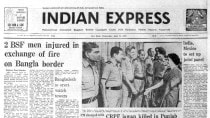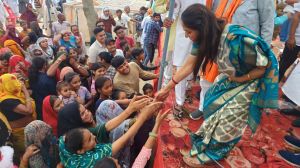- India
- International
Routine meetings between leaders will liberate the Subcontinent from formalism of summits
Rather than pray for the success of SAARC, the new government in Delhi should double down on informal diplomacy that could help pave the way for more purposeful regional cooperation — both bilateral and multilateral.
 Prime Minister Narendra Modi during a press conference at the party headquarters in New Delhi. (PTI)
Prime Minister Narendra Modi during a press conference at the party headquarters in New Delhi. (PTI)
With Narendra Modi looking set to return as India’s prime minister, might he want to start his second tenure by inviting all leaders of the neighbouring countries for his inauguration? Five years ago, in May 2014, Modi surprised the region and the world with his invite and spent the first day in office talking to the visiting leaders from the neighbourhood, including the eight South Asian countries as well as Mauritius. If the 2014 invite generated much diplomatic buzz, it will certainly look less dramatic the second time around. But the invitation for the 2019 swearing-in would hopefully make it a custom and an integral part of Delhi’s political renewal every five years.
It is not that the new Indian PM will sit down for negotiations on contentious issues with the visiting leaders. The purpose of having an open-house for leaders from the neighbourhood at the launch of a new government in Delhi is about informal diplomacy — of establishing or renewing personal contact, building mutual trust and generating the political will for resolving the multitude of problems that exist between neighbours.
Others in our neighbourhood too seem to like the idea. When he was sworn in as president of Maldives last November, Ibrahim Mohamed Solih invited the Indian PM to be present. Modi readily accepted and traveled down to Male for a few hours to be at the ceremony.
Earlier in August 2018, when Imran Khan was taking charge as Pakistan’s Prime Minister, he toyed with the idea of emulating Modi by inviting foreign leaders for his swearing in ceremony. But the proposal did not fly and Imran limited himself to inviting friends from India — including former cricketer and Congress leader, Navjot Singh Sidhu.
If Modi used the invitation in 2014 to signal his commitment to South Asian regionalism, he was also quick to see the limitations of SAARC (the South Asian Association of Regional Cooperation) at the Kathmandu summit in 2014. The summit had failed to sign off on the connectivity agreements that were painfully negotiated by senior officials, because Pakistan chose to pull out at the last stage. Apparently Rawalpindi was not ready for trade and economic cooperation with India.

At Kathmandu, Modi recognised that South Asian regionalism can’t be allowed to become a hostage to Pakistan. To be sure, Islamabad had the sovereign right to decide on the need, nature and pace of its integration with the rest of the subcontinent. The only sensible course, then, is for the rest of the SAARC to move forward wherever they can and let Pakistan join the process whenever it feels comfortable.
Since then Delhi has emphasised other multilateral mechanisms — including sub-regional cooperation between Bangladesh, Bhutan, India and Nepal and trans-regional cooperation in the east — the littoral of the Bay of Bengal including Burma and Thailand. Modi also revived the bilateral engagement with countries like Sri Lanka that were constrained in the UPA years — thanks to Tamil Nadu’s veto over the engagement with Colombo.
Regular official visits to the neighbouring capitals have become the norm at all levels. Early on in his tenure, Modi chose to travel to most neighbouring countries as well as Mauritius and Seychelles. It has become the convention for any new foreign secretary to travel first to all the neighbouring capitals.
Beyond the formal visits, Modi found opportunities to drop by in the neighbourhood — to pray at the Pashupatinath temple in Kathmandu during 2014 and visiting Nawaz Sharif at his home outside Lahore on the occasion of his birthday at the end of 2015. There is also the tradition of South Asian leaders making unofficial visits to temples and dargahs in India.
The Subcontinent can do with more of this kind of engagement — leaders seeing each other on short notice for informal consultations or just watch a cricket match or join a social or spiritual occasion. Informal diplomacy in South Asia will make it easier for India to sustain high-level engagement with the neighbourhood, given the increasingly crowded formal diplomatic calendar of the PM. These include pre-set multilateral summits — from BRICS and SCO to the ASEAN, G-20 and the UN — as well as annual meetings with friendly nations through the year.
Meanwhile, some of these multilateral summits could throw up the possibilities of a meeting with the Pakistani leadership. There is already speculation on the prospects of a meeting between Modi and Imran on the margins of the SCO summit in Central Asia next month. Is it not much simpler to meet Imran in Delhi next week rather than Bishkek, Kyrgyzstan at the end of June?
There is no rule which says an Indian PM can’t meet his Pakistani counterpart without it involving a negotiation of differences. If meetings with Pakistan’s leadership become routine and informal, Delhi will be able to prevent each encounter seem like a gladiatorial contest that must address all issues and produce joint statements, every word of which is analysed to death.
While Pakistan is a special case, informal high level diplomacy could also help liberate the region from the stuffy and unproductive formalism of the SAARC. Rather than pray for the success of SAARC, the new government in Delhi should double down on informal diplomacy that could help pave the way for more purposeful regional cooperation — both bilateral and multilateral.
This article first appeared in the print edition on May 21, 2019 under the title ‘The case for informal regional diplomacy’. The writer is director, Institute of South Asian Studies, National University of Singapore and contributing editor, international affairs for The Indian Express.
EXPRESS OPINION
More Explained
Apr 25: Latest News
- 01
- 02
- 03
- 04
- 05











































